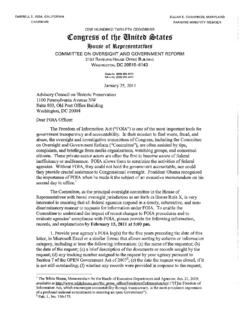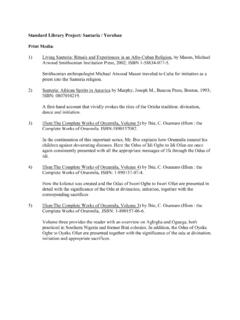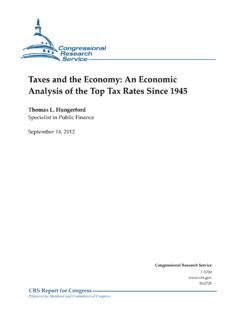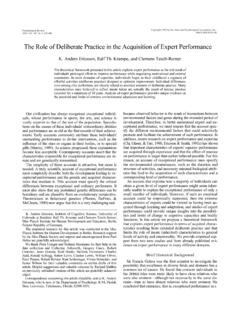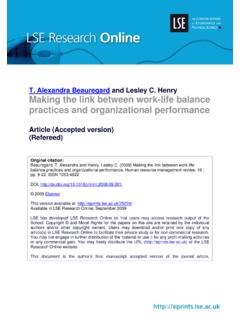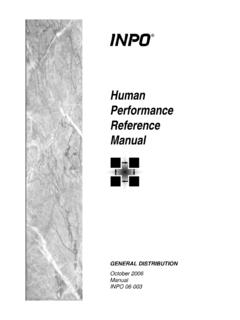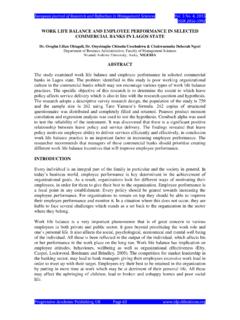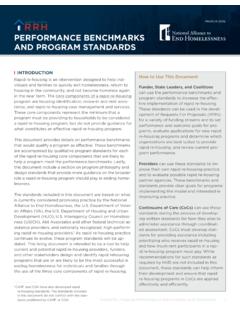Transcription of Psychology of Music http://pom.sagepub.com/content/33/2/173
1 Psychology of Music The effect of Music listening on work performance Teresa Lesiuk Psychology of Music 2005 33: 173. DOI: The online version of this article can be found at: Published by: On behalf of: Society for Education, Music and Psychology Research Additional services and information for Psychology of Music can be found at: Email Alerts: Subscriptions: Reprints: Permissions: Citations: >> Version of Record - Mar 30, 2005. What is This? Downloaded from at UNIV OF MIAMI on August 3, 2012. A RT I C L E 173. The effect of Music listening on Psychology of Music Psychology of Music work performance Copyright . Society for Education, Music and Psychology Research vol ( ): [ - . ( ) : ; ].. TERESA LESIUK. U N I V E R S I T Y O F W I N D S O R , C A N A DA. A B S T R AC TThis study measured the effect of Music listening on state positive affect, work quality and time-on-task of computer information systems developers. Effects of Music on work performance , in this case, software design, may be explained by increases in state positive affect.
2 Data from 56 (male = 41, female = 15) developers were obtained from four different Canadian software companies. Data were collected in the participants' actual work environments over five weeks. Results indicated that state positive affect and quality-of-work were lowest with no Music , while time-on-task was longest when Music was removed. Narrative responses revealed the value of Music listening for positive mood change and enhanced perception on design while working. Evidence is provided of the presence of a learning curve in the use of Music for positive mood alteration. Overall, the study contributes to the development of a model that aspires to elucidate Music and workplace interactions; as well, it has implications for organizational practice. K E Y W O R D S : affect, computer software design, creativity, mood, Music Psychology , productivity, work stress Productivity, or quality-of-work,' in computer information systems design may be measured by creativity of the software design.
3 Creativity, the ability to produce work that is both novel and appropriate (Sternberg and Lubart, 1999), is adversely affected by stress and certain moods. Mild positive feelings have been found to influence positively the way cognitive material is organ- ized, thus influencing creativity. A beneficial effect of Music on task perform- ance may be explained by increases in state positive affect (Isen, 1999;. Schellenberg, 2001; Thompson et al., 2001). When Music evokes a pleasant mood and an increased arousal state, participants perform better on non- musical tasks. Thus, there is support for an increase in creative problem sempre : Downloaded from at UNIV OF MIAMI on August 3, 2012. 174 Psychology of Music 33(2). solving and task performance by workers, in this case, computer systems developers. Computer software developers The designing of computer systems is part of a larger industry known as Information Technology (IT), an industry that is competitive, continually changing, and one that constantly requires creative approaches in software design.
4 The trend to downsize' or rightsize' is reported to lead to stress for computer developers and detrimental consequences for their design work (Glass, 1997; Wastell and Newman, 1993). Fujigaki (1993) found stress present throughout almost all software work phases of systems development, even taking on different forms in two different phases. During the requirements- definition and design stage (involving planning and designing a software system) stress responses were in the form of high anxiety and depression, while during the coding phase, the stress took on the form of irritability and falling morale. Further, Fujigaki maintains that designing of systems is particularly vulnerable to stress-caused errors. He found that 42 percent of all design faults were directly attributable to programmer stress explaining that deep thinking, such as searching for solutions in a huge problem space .. is required in the design phase .. and is easily affected by stress, which causes imperfect investigation' (p.)
5 34). Music and affect Past Music and affect theories underlie the basic affective responses of indi- viduals who partake in Music listening. Present-day theories build on the past theories, and eventually help construct a fuller picture of Music listening within a work context. Fiske (1996) eloquently dismantles the common notion that Music is a language of the emotions.' Shared cultural knowledge of emotions suggests that Music communicates knowledge across groups of listeners, but cultural knowledge does not take account of an individual's personal experiences. In his critique of several pertinent Music and affect theories ( , Kivy, 1990; Langer, 1967; Meyer, 1956), Fiske concludes that mood states following Music listening are the result of an individual's unique past experiences. He clarifies the difference between aesthetic response and listener mood state responses to Music . That is, mood states occur as a result of individuals projecting their many past experiences and beliefs (with the inherent emotional content) onto their experience of the tonal rhythmic events presented in Music .
6 Conversely, an aesthetic response is the outcome of the listener's relative understanding of tonal rhythmic pattern interrelationships. A number of studies suggest that Music experiences produce felt peak experiences (Goldstein, 1980; Panksepp, 1995). Sloboda (1991) examined Downloaded from at UNIV OF MIAMI on August 3, 2012. Lesiuk: The effect of Music listening on work performance 175. peak' experiences to Music listening, including measurable emotional responses such as thrills, shivers, laughter, lump in the throat, and tears. Reported peak experiences that coincided with specific musical structures were perceived by the researcher as metaphors. For example, the physical response of tears evoked by endings in the Music may be understood as a type of metaphor of either loss or relief. These types of metaphors provide a cathartic outlet, allowing listeners to impose their own emotion-stories' on Music experiences, and are psychologically beneficial for motivation and self- image.
7 Of importance to the present Music and work study, Sloboda reported that repeated listening to a piece of Music did not diminish strong emotional responses. Music may also serve as an anxiolytic treatment, that is, an anxiety pre- ventative or anxiety reducing measure. Knight and Rickard (2001) explored the effect of sedative Music on participants' subjective and physiological stress levels following a cognitive stressor involving preparation of an oral presentation. Significant increases in physiological stress were reported for those who prepared the task without Music , while the presence of Music suppressed significant increases in subjective anxiety, systolic blood pressure, and heart rate. Further, individuals value their own or preferred Music ' when consider- ing the Music that best relaxes them. Following a comparison of five different types of Music Stratton and Zalanowski (1984) reported a significant corre- lation between degree of relaxation and preference for Music .
8 Davis and Thaut (1989) reinforced the importance of preference in a study measuring physiological and psychological subjective responses to preferred, relaxing Music . Varying types of Music chosen by the subjects were effective in reduc- ing anxiety. The researchers concluded that preference, familiarity or past experiences with the Music may have an overriding effect on positive behaviour change than the type of Music . Additionally, significant within- subject results were reported for the physiological measures, and the researchers concluded that idiosyncratic responses occur in a habitual manner to Music preference. Of relevance to the computer software development community, Lesiuk (2000) reported decreased levels of state anxiety when Music was used prior to and throughout a computer programming task. Seventy-two students in an introductory computer programming course were assigned to a group with either (1) no Music , (2) Music prior to, or (3) Music prior to and during a task requiring students to locate syntax in logic errors.
9 Results indicated a statistically significant effect of the Music listening on state anxiety levels. Most importantly, the group with Music prior to and during the task experi- enced the least amount of anxiety. While there was no statistically significant difference between groups for the programming task, the group with the most Music achieved the highest mean scores in both tasks. Everyday emotional responses to Music are not without a social context Downloaded from at UNIV OF MIAMI on August 3, 2012. 176 Psychology of Music 33(2). (DeNora, 2001; Hargreaves and North, 1999). Sloboda and O'Neill (2001). investigated everyday emotional responses to Music by employing a method known as the experience sampling method (ESM) in which real-world'. events are studied as they unfold in everyday life. Participants carried pagers during their waking hours and were paged randomly once within every two hours daily for a period of one week. When paged, participants recorded their current activity in a response booklet with the purpose of capturing everyday emotional experiences associated with Music .
10 The study reports that 44. percent of all pagings (or episodes') involved Music . An analysis of recorded emotional responses revealed that Music experiences increased positivity, alertness, and focus on the present. The researchers concluded that, in general, Music made the participants feel better.'. Music and work studies A number of earlier studies has shown the beneficial effects of Music listen- ing on work productivity (Fox, 1971; Kirkpatrick, 1943; Wokoun, 1969). Presenting extraneous environmental stimuli by way of stereo headsets ( Music and radio) is one way in which work performance has shown improvement (Oldham, 1995). An analysis of listening habits such as Music type selection, duration of listening, and shifting from one Music type to another revealed little relation to outcomes such as employees' moods and productivity, job satisfaction and turnover intentions. The mood state of relaxation best explained the relationship between the use of the stereos and productivity, and environmental interference most effectively explained the relation between the stereo use and organizational satisfaction.

